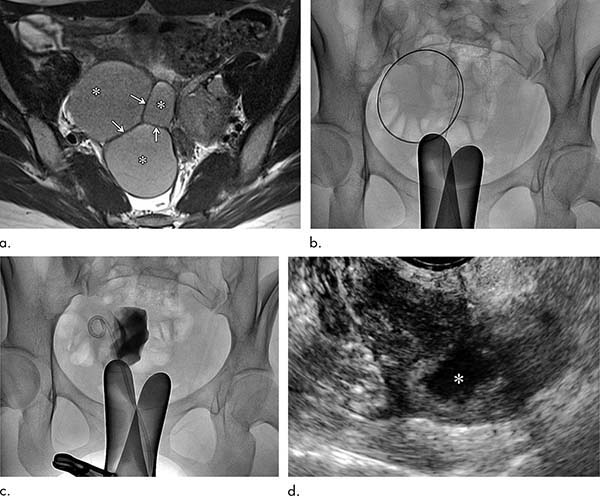Novel Technique to Treat Endometrial Cysts is Safe and Effective
Common condition affects 10 percent of women of reproductive age.
August 28, 2018

Kim
Catheter-based sclerotherapy is a safe and effective treatment for endometrial cysts and could help preserve fertility in patients, according to a study in Radiology.
When endometriosis involves the ovaries, endometriomas may form, causing pelvic pain and abnormal uterine bleeding.
Surgery is a common treatment for endometriomas, but it carries risks, including the removal of healthy ovarian tissue, which can affect fertility. Needle-based sclerotherapy is a less-invasive option that involves inserting a needle into the cyst under ultrasound guidance and then withdrawing the cystic fluid through a needle. The cyst is then washed with a solution of ethanol. However, the needle-directed approach has limitations, said study co-author Man-Deuk Kim, MD, PhD, professor at Severance Hospital, Yonsei University College of Medicine in Seoul, South Korea.
“Endometrial cyst content can be incredibly thick and sticky. A 16- or 18-gauge needle, which is commonly used for needle-directed sclerotherapy, is sometimes not large enough to completely evacuate the cyst,” Dr. Kim said. “This may reduce the efficacy of sclerotherapy and increase the possibility of needle displacement during aspiration.”
Dr. Kim and colleagues studied a sclerotherapy technique that replaces the needle with a catheter. Along with draining cystic fluid more easily, a catheter allows for positional changes during the procedure, which helps maximize the ethanol’s effectiveness by enabling it to contact the cyst wall evenly. The catheter also reduces the risk of spillage into the peritoneal cavity of the abdomen.
When endometriosis involves the ovaries, endometriomas may form, causing pelvic pain and abnormal uterine bleeding.
Surgery is a common treatment for endometriomas, but it carries risks, including the removal of healthy ovarian tissue, which can affect fertility. Needle-based sclerotherapy is a less-invasive option that involves inserting a needle into the cyst under ultrasound guidance and then withdrawing the cystic fluid through a needle. The cyst is then washed with a solution of ethanol. However, the needle-directed approach has limitations, said study co-author Man-Deuk Kim, MD, PhD, professor at Severance Hospital, Yonsei University College of Medicine in Seoul, South Korea.
“Endometrial cyst content can be incredibly thick and sticky. A 16- or 18-gauge needle, which is commonly used for needle-directed sclerotherapy, is sometimes not large enough to completely evacuate the cyst,” Dr. Kim said. “This may reduce the efficacy of sclerotherapy and increase the possibility of needle displacement during aspiration.”
Dr. Kim and colleagues studied a sclerotherapy technique that replaces the needle with a catheter. Along with draining cystic fluid more easily, a catheter allows for positional changes during the procedure, which helps maximize the ethanol’s effectiveness by enabling it to contact the cyst wall evenly. The catheter also reduces the risk of spillage into the peritoneal cavity of the abdomen.

Clinical course of a 27-year-old woman with primary ovarian endometrioma presenting with dysmenorrhea. (a) Axial T2-weighted image reveals an 8.4-cm, multilocular endometrioma (∗) with internal septation (arrows). (b) The endometrioma was punctured and mechanical breakdown of the internal septa was performed. (c) A catheter was inserted and contrast agent was injected to observe for any leakage. (d) Follow-up ultrasound 6 months after catheter-directed sclerotherapy shows markedly decreased endometrioma (∗) size (1.4 cm).
The researchers evaluated catheter-directed sclerotherapy with 95 percent ethanol in 14 women between the ages of 20 and 44 with ovarian endometriomas.
After about one year, the cysts had decreased on average from 5.8 centimeters (cm) in diameter to 1.1 cm. Pain was relieved in all patients and blood tests indicated well-preserved ovarian function. There were no procedure-related complications.
There were no endometrioma recurrences, even in patients with internal septation within their cysts. In catheter-directed sclerotherapy, once the endometrioma is punctured, clinicians can manipulate the guidewire and catheter to break down internal septations, allowing for more effective treatment.
“In our study, the recurrence rate of catheter-directed sclerotherapy was 0 percent, which is very encouraging given that endometriomas measuring up to 13.5 centimeters in diameter or those that had internal septation were included in the study,” Dr. Kim said.
The results suggest that catheter-based sclerotherapy could lead to better short-term clinical outcomes in women with endometrial cysts while preserving ovarian function and improving future fertility, Dr. Kim noted.
After about one year, the cysts had decreased on average from 5.8 centimeters (cm) in diameter to 1.1 cm. Pain was relieved in all patients and blood tests indicated well-preserved ovarian function. There were no procedure-related complications.
There were no endometrioma recurrences, even in patients with internal septation within their cysts. In catheter-directed sclerotherapy, once the endometrioma is punctured, clinicians can manipulate the guidewire and catheter to break down internal septations, allowing for more effective treatment.
“In our study, the recurrence rate of catheter-directed sclerotherapy was 0 percent, which is very encouraging given that endometriomas measuring up to 13.5 centimeters in diameter or those that had internal septation were included in the study,” Dr. Kim said.
The results suggest that catheter-based sclerotherapy could lead to better short-term clinical outcomes in women with endometrial cysts while preserving ovarian function and improving future fertility, Dr. Kim noted.